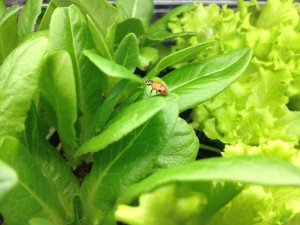I have a couple of mushroom projects going on.Shiitake - I am on my second round of growing Shiitakes that I ordered from 100th Monkey Mushroom Farm. I had been wanting to try growing them for a couple of reasons. They grow well indoors, I am using Shiitake all the time in my homemade ramen noodle soup and what a conversation piece!I ended up ordering from this company because I loved the tutorial videos with Jim on their YouTube channel. The Shiitake video gives tips on getting 3 full growing rounds out of the block which costs $33 (before shipping) for an estimated total harvest of 2-3 lbs.My first round with the Shiitake blocks (I ordered and grew two of them) resulted in 10.2 oz fairly split between the two.
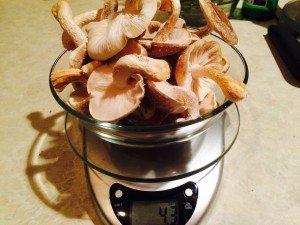 The second round is a bit more asymmetrical with Block B doing well and Block A (which slightly outperformed Block B in the first round) doing nothing so far.
The second round is a bit more asymmetrical with Block B doing well and Block A (which slightly outperformed Block B in the first round) doing nothing so far.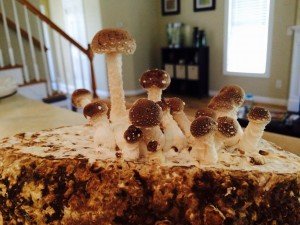 Time will tell and I am looking forward to the third round when I will layer the block medium along with straw into a plastic planter with holes drilled in the sides for the final opportunity to grow and harvest.Before I started this project I made note of what I was purchasing Shiitakes for ($1.10 oz) to compare my $33 investment to the retail costs. I have a ways to go to make this project actually be a money saver, but it has been fun and I know the mushrooms I am enjoying are fresh, well grown and harvested within 5 days of use making the monetary aspect more of a fun side project.Next on my list to try are the Elm Oyster Mushrooms from this same company. As soon as I figure out which recipes to use them in, I will be ordering a box kit.Morels - my other mushroom project is one that mushroom enthusiasts have long thought impossible - cultivating morels! These elusive and highly prized forage mushrooms have proven impossible to cultivate for decades, but a couple of companies believe they have cracked the code and are now selling morel spawn along with cultivating instructions.This is more of a long term project since the instructions specify that real production is not expected until the second spring after bed preparations. I purchased my kits from Gourmet Mushrooms and I started two 4 square foot beds about 20 feet apart to try this for myself. I grew up hunting morels in spring and have found them at the Farmer's Market selling for upwards of $20 lb. in the past few years. They are a wonderful, seasonal treat and the idea of harvesting them from my back yard for years to come was well worth the $33 per kit. Due to the time involved and the weekly compost feeding required, this project is not for everyone but if you are dedicated to the idea of having a ready supply of morels in an easy to harvest location, it might be worth your while.
Time will tell and I am looking forward to the third round when I will layer the block medium along with straw into a plastic planter with holes drilled in the sides for the final opportunity to grow and harvest.Before I started this project I made note of what I was purchasing Shiitakes for ($1.10 oz) to compare my $33 investment to the retail costs. I have a ways to go to make this project actually be a money saver, but it has been fun and I know the mushrooms I am enjoying are fresh, well grown and harvested within 5 days of use making the monetary aspect more of a fun side project.Next on my list to try are the Elm Oyster Mushrooms from this same company. As soon as I figure out which recipes to use them in, I will be ordering a box kit.Morels - my other mushroom project is one that mushroom enthusiasts have long thought impossible - cultivating morels! These elusive and highly prized forage mushrooms have proven impossible to cultivate for decades, but a couple of companies believe they have cracked the code and are now selling morel spawn along with cultivating instructions.This is more of a long term project since the instructions specify that real production is not expected until the second spring after bed preparations. I purchased my kits from Gourmet Mushrooms and I started two 4 square foot beds about 20 feet apart to try this for myself. I grew up hunting morels in spring and have found them at the Farmer's Market selling for upwards of $20 lb. in the past few years. They are a wonderful, seasonal treat and the idea of harvesting them from my back yard for years to come was well worth the $33 per kit. Due to the time involved and the weekly compost feeding required, this project is not for everyone but if you are dedicated to the idea of having a ready supply of morels in an easy to harvest location, it might be worth your while.
Bloomin' Blueberries
During a very busy, task oriented day of seeding another 5 basil pots indoors, preparing the outdoor garden beds for hoop row covers to keep falling pine needles and cones out of the beds and starting another 16 dwarf collards, something caught my eye. The Premier Blueberries I migrated from containers to their permanent homes in the ground behind my deck back in July when I bought my house are blooming! These are my first blueberry bushes and my first blooms. Although I am concerned that they should be focusing on root growth and stability before the impending winter rather than flaunting their fecundity in the wrong season, I was so absolutely taken with the perfectly beautiful little bell blossoms that I stopped everything to snap a picture and revel in their elegance.
From 6a to 7b
Where Is NearlyHomeGrown?In 2012 I purchased 10 raised bed kits, filled them with the mix recommended by Mel Bartholomew (1/3 peat moss, 1/3 vermiculite, 1/3 compost) and had an intensive planting plan which resulted in an abundant harvest. I doubled the size of my indoor garden, started growing microgreens (in addition to, not instead of their macro counterparts) and started the whole process over for 2013 with lessons learned and plans for an even bigger garden.In May of 2013 a job opportunity arose that moved me from Wichita, Kansas (Hardiness Zone 6a) to Raleigh, North Carolina (Hardiness Zone 7b). Because I had purchased a durable raised bed product and made my own soil for my garden, I brought my garden with me. I spent a year renting a town home with no backyard but with a nice patio that I quickly filled with container trees and potted herbs while 2,000 lbs. of homemade soil in 40 gallon Rubbermaid containers sat waiting in my garage.In July of this year I purchased a home. Moving in meant unpacking boxes but also setting up my outdoor and indoor gardens and adding some fig trees and blueberry bushes to the productive capacity of my .2 acre lot and starting plans for even more variety in my plantings.That is a rough overview of what I have been up to since my last post. I have some interesting projects growing...
Spring is Springing
The Winter That Never Happened has passed and Spring appears to be here to stay. I have been wrapped up in both gardening and non-gardening projects for the last few months and have fallen behind in posting despite the dozen or so things I know I need to get written.Stay tuned, I will get caught up soon!
How Does My Garden Grow - Part 2
In mid December the indoor garden was really taking shape. The lettuce was doing great and providing a couple of salads a week, the spinach was coming along and the 3 basil plants I purchased from Wild Family Farm over the summer were looking seriously picked over due to my insatiable appetite for fresh basil on almost every meal.And then everything changed.On a shopping trip to Green Acres I spied some potted basil plants from a local greenhouse. I picked two of the most likely plants and congratulated ourselves on giving my basils at home a well earned rest and recoup. I took the new basils home and introduced them to my garden not knowing they were carrying aphids. Very healthy, fecund aphids.About a week later the aphid infestation became apparent. They engulfed the spinach, the swiss chard, the lettuce, the basils and even the kale! The only plants that were safe were the oregano, rosemary and chives.Prior to the introduction of the new basil plants, I essentially had a sterile environment. The previous owner had not had a single houseplant, and before my indoor garden, neither did I. After discovering the invasion, I quickly researched my opponent and learned that aphids are the bane of gardeners everywhere. I researched treatments methods that are considered organic and headed to the local Menard's. The first line of defense was Neem. I followed the instructions and made sure to get the undersides of leaves where aphids like to hang out. I used it for two weeks as directed and it reduced the aphid population, but then they rebounded again. I moved down the list and made a second attempt with a pyrethrin mix with the same results, an initial reduction in aphid population followed by a resurgence.Despite two disappointing experiences, I still wanted to stay organic if possible and decided it was time to try diatomaceous earth. Everything I read said this stuff would prove lethal not only to the aphid population, but also to any spiders, soft bodied flies or other insects that wondered too close. I coated all of the plants including the ones the aphids were avoiding. I coated the tops of the leaves, the undersides of the leaves, the top of the soil mix, I coated everything! Three weeks later all I had to show for this was dusty aphids.I had three choices at this point; go with some serious chemicals that would keep me out of the organic club, put all of my inside plants outside and let winter kill the aphids and the plants and try again in a month or so when I could be sure that all the aphids were gone or natural predators. I opted for the natural predator route with the caveat that if this didn't work, I was going to kill everything and start over. I ordered the ladybugs from a company with good reviews and 1,600 squirming ladybugs arrived a few days later.
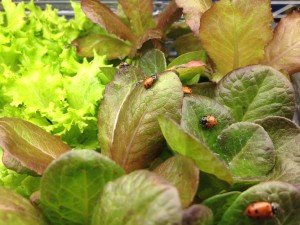 (ladybugs walking on the Merveille des Quatre Saisons lettuce)
(ladybugs walking on the Merveille des Quatre Saisons lettuce)
I released the ladybugs on all of the plants and waited. One day later the aphid population was scarce. Two days later I could not find an aphid anywhere! It has been two weeks now and the ladybug population is down to maybe 150, but still no aphids to be found. I have a suspicion that there are aphid eggs waiting to hatch, but also a hunch that the ladybugs may have pulled off the same trick due to the difficulty I had trying to take a photo that didn't include mating ladybugs! So I have high hopes that if there is a round of aphid hatchlings in my future, there will also a be a resurgence of the ladybug population around the same time.
New Find
I discovered a real gem this weekend - a blog called DigginFood.com with great companion videos under the name Grow.Cook.Eat. Willi Galloway and her husband Jon are urban gardeners in Seattle at their "little urban homestead" where they grow and cook a wide variety of foods fresh from their backyard garden.The blog dates back to April 2008, which is good news since I ran through all the videos already. They also have a book called Grow Cook Eat that I will put on my must read list.If you are looking for some fresh ideas for fresh food this is a great site!
What I Am Reading at NHG
I had a reader request for a recommended book list. Some of these books have been mentioned in other posts, but here is a list of what I've read so far in no particular order:Folks, this Ain't Normal by Joel SalatinAnimal, Vegetable, Miracle by Barbara Kingsolver with Steven Hopp and Camille KingsolverThe Omnivore's Dilemma by Michael PollanIn Defense of Food by Michael PollanSecond Nature by Michael PollanThe Botany of Desire by Michael PollanFast Food Nation by Eric SchlosserPandora's Seed by Spencer WellsTomatoland by Barry EstabrookOn my wish list:You Can Farm by Joel SalatinEverything I Want To Is Illegal by Joel SalatinSheer Ecstasy of Being a Lunatic Farmer by Joel SalatinSalad Bar Beef by Joel SalatinFamily Friendly Farming by Joel SalatinHoly Cows and Hog Heaven by Joel SalatinChew On This by Charles Wilson and Eric SchlosserSlow Food Nation by Carlos Petrini
How Does My Garden Grow
The lettuce and spinach I sowed on November 5th are doing very well. I waited until today to thin the plants so the non-winners in this evolutionary race could still make a small salad.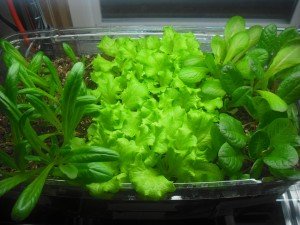 I have started a second batch that is beginning to sprout and hope that the staggering will keep me in fresh greens until spring when I can sow outdoors.I am also experimenting with a couple seeds of Five Color Silverbeet Swiss Chard. I am starting them in very small containers and will transplant into larger containers to grow indoors if they germinate well.My indoor growing space is at a premium right now and I am looking to expand what I can grow by doubling up on the growing shelves and lights with 2 deep on the wide shelves. At this rate I will probably need a second shelving unit before spring, but I am loving the results. This project is not a money saver right now. I have a long, long way to go before indoor gardening pays for itself, but I love being able to go downstairs and get some "just in time" basil, lettuce, rosemary, or oregano.
I have started a second batch that is beginning to sprout and hope that the staggering will keep me in fresh greens until spring when I can sow outdoors.I am also experimenting with a couple seeds of Five Color Silverbeet Swiss Chard. I am starting them in very small containers and will transplant into larger containers to grow indoors if they germinate well.My indoor growing space is at a premium right now and I am looking to expand what I can grow by doubling up on the growing shelves and lights with 2 deep on the wide shelves. At this rate I will probably need a second shelving unit before spring, but I am loving the results. This project is not a money saver right now. I have a long, long way to go before indoor gardening pays for itself, but I love being able to go downstairs and get some "just in time" basil, lettuce, rosemary, or oregano.
Winter Market
Today was the first of two Winter Markets for the Kansas Grown Farmer's Market. The market was held inside the extension building which was a bonus with winds today gusting up to 37mph.I visited with Indian Creek Bison Ranch, a farm that I had seen many times at the entrance to the market but never purchased from before. All the bison are grass-fed, antibiotic and steroid-free so I walked away with a pack of frozen bison burgers to try.I also visited with Morning Harvest Farm that specializes in pastured poultry, pastured eggs and grass-fed beef. Paula was wonderful to talk with and I learned that she shares my passion for Joel Salatin books. Her pastured poultry schooners look to be based on his egg-mobiles. I purchased a package of summer sausage and beef links and grabbed a brochure for her farm.After getting home and getting all the market goodies put away I spent some time with the Morning Harvest Farm brochure and am even more intrigued. They also offer herbs, vegetables and farm raised fish. They have a CSA (Consumer Supported Agriculture) program that runs year round and allows you to select the products you receive. According to the website all CSA shares for Morning Harvest Farms are sold and the waiting list is full. Based on their farm and products I am not surprised. I will be checking back regularly to see when they have an opening on the wait list.
My Secret Garden
Maybe all new gardeners are as anxious as I am to get started. Maybe they all look at the approaching first frost date and say "I can outsmart nature". Maybe not. Either way, Patti Moreno made me do it.I have been watching a lot of the Patti Moreno, Garden Girl videos to learn about her version of Square Foot Gardening. In one episode she turns a sun room in her home into a nursery for her plant starts for spring with shelving and fluorescent fixtures and full spectrum grow lights. It was late October and I knew that I would want to get a head start on spring so I created a couple of grow shelves in my basement in front of a southern exposure window with the bulbs that Patti recommended and a timer. Besides, I still have those 3 basil plants that I purchased from the Farmer's Market this summer that I would like to keep going for as long as possible into the winter months as well as two rosemary varieties and an oregano.I waited one week.On November 5th I could wait no more (I already mentioned that Patti made me do it, right?). I knew that spinach and lettuce are cool weather plants and my basement stays just below 70 degrees. I had already received my order of Baker Creek Heirloom Seeds for my spring plantings and thought "why not see what happens?".I planted 3 varieties of heirloom lettuce and 2 varieties of heirloom spinach. The goal is to be able to cut off a couple of leaves of the still growing plants to enjoy some fresh greens between now and when the real plantings happen next growing season.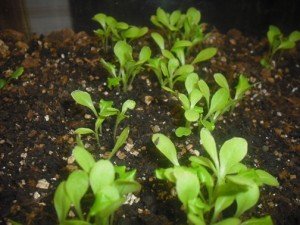 Less than 2 weeks later I have little lettuce and spinach starts in my secret garden. I hope that in another few weeks I will be able to begin harvesting leaves. I have another set of grow containers ready to go to get more started when I begin harvesting from this first run. I hope to continue this cycle until the Farmer's Markets reopen in May.
Less than 2 weeks later I have little lettuce and spinach starts in my secret garden. I hope that in another few weeks I will be able to begin harvesting leaves. I have another set of grow containers ready to go to get more started when I begin harvesting from this first run. I hope to continue this cycle until the Farmer's Markets reopen in May.
There's An App For That
On a whim I went to the Apple app store and searched 'vegetable garden' to see what would come up. Currently there are 21 apps available. Some looked ho-hum but there were a few that look like they might be useful with diaries, soil and plant tips, planting and harvesting guides and even pest identification. I may have to give it a try and see if a high-tech mentor will guide me through the first year of being a back-yard gardener.
Something Cooking At Nearly Home Grown
I have found myself thinking of the Ant and the Grasshopper over the past 2 months as I have busily worked to build up a full freezer's worth of frozen tomato paste, whole roasting chickens and chicken breasts, butternut squash, spinach and basil hoping that each will manage to retain a bit of the freshness and vitality of summer.Storing the bounty of this year and hoping it will tide me over until the first farmer's market of the spring has inevitably led to thoughts of what next year will bring to the table and freezer. After much thought, planning, reading four Michael Pollan books, one Barbara Kingsolver book and watching more videos from Patti Moreno than I can count, I have decided to start my own garden for 2012 to supplement the organics I purchase from the farmer's markets.I will be experimenting with the Square Foot Gardening method created by Mel Bartholomew with heirloom, open pollinated seeds from Baker Creek Heirloom Seeds and Seed Savers Exchange. I have already learned that there are more different vegetables and varieties of each than our meager yard can contain so I have had to use the cold eye of an executioner to whittle down the roar of 'wants' to a manageable list of 'needs'. Maybe next year will herald some truly home grown goodness here at Nearly Home Grown...In the meantime, I will keep updating with recipes from this year, planning for next year and anything related to local food that sparks an interest!
Winding Down
This weekend I got my first real sense that it was time for the Farmer's Markets to wind down for the year. I visited the Neosho Farms stand to pick up some onions and garlic and asked whether a special they were having on garlic would be available next weekend. The answer was "this is our last weekend for the year".I immediately headed over to Cheney Lake Tomatoes to talk to John about his tomatoes that are sold at Green Acres Market. I asked if there would be any gaps this winter and how often he delivered tomatoes to GAM. I have become attached to my homemade pasta sauce and am having a hard time imagining going back to the jarred stuff this winter. I have looked into canning but am not quite ready to take the plunge just yet.With the end of the season nearing, we will be at the market every Saturday between now and the official end trying to take in a little more of the locally grown, fresh produce and the last of the summer days.
Odds and Ends
So a couple of ideas to mix up some of the recipes posted here:Homemade croutons are as easy as leftover bread from pasta night! I have been adding these to the Tomato Salad for the past couple of weeks and they are a little bit of heaven.Cut leftover bread into cubes, about 2 cups worth2 TBS of butterSprinkle of garlic saltMelt the butter on low-med heat. Add bread cubes and toss until well covered. Let cook until golden brown on one side then turn. Continue until most sides are golden and bread is crunchy. Remove from heat and sprinkle with garlic salt.Another idea that I have been using to mix it up (mix it up in this context means hiding healthy food in kid-friendly food) is adding puree to the homemade pasta sauce. I keep frozen spinach, carrot and butternut squash puree on hand at all times. It is amazing how many dishes you can slip one or more of these into without altering the taste, consistency or the likelihood that it will be eaten by kids under the age of 7. One of my favorites is to add one TBS of each to the pasta sauce about 5 minutes before it is done, enough so it is heated thoroughly and blended, but without cooking out all the healthy goodness. Having purees on hand is easy as this:Pick your vegetableSteam until tender (this varies wildly from 1-2 minutes for spinach to 20 minutes for butternut squash)PureeUse your measuring spoon to put TBS dollops on a sheet of wax paper. Place in freezer until frozen. Remove from wax paper and put into freezer safe bags and voila! You have pre-measured TBS of your favorite vegetable puree to thicken up soups and sauces or to add a little extra nutrition to an otherwise ho-hum dish.
Souped Up
In the middle of what seems like the longest heat wave in history, my 4 year old came down with a head cold. Last weekend I had noticed homemade egg noodles at the Phil's Family Farm booth at the KGFM, so this weekend I stopped by Phil's and picked up 2 8oz bags of the homemade narrow egg noodles.I have a family recipe for chicken noodle soup that calls for boiling a chicken until all that is left is tasteless muscle fiber and using the resulting broth for the soup base. I had also picked up a free range fryer from Phil's, but it seemed like such a waste so I opted to use organic chicken broth instead. I use Pacific Natural Foods low sodium, but any broth you use should be fine.Chicken Noodle Soup8 cups chicken broth3 organic carrots, peeled and thin sliced8 oz. egg noodlesSalt and pepper to taste.Bring broth and carrots to a boil then reduce heat to a simmer. Cook for 20-30 minutes or until carrots are cooked to desired tenderness. Add noodles and cook 7-10 minutes or until noodles are done. Salt and pepper to taste. Makes about 7 servings.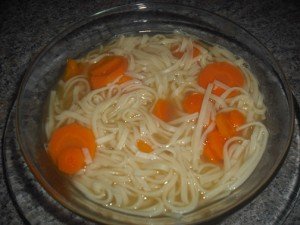
Mangia
I have been fine-tuning a pasta sauce recipe for a few weeks and I think it is as close to 'right' as it is going to get for now. So on Saturday I headed to the Kansas Grown Farmer's Market for fresh tomatoes, garlic and onion. I knew that Saturday was the big annual Tomato Day at the market so hopes were high until ...Cheney Lake Tomatoes had enough for my purposes, so I gathered my other items and headed over to the Old Town Farmer's Market.The Old Town market is more artsy than the Kansas Grown. There are more 'other' stands than fresh produce stands, but they have one that I have been going back to week after week - Pappardelle's by local vendor Pastalicious. I have tried 4 or 5 of their varieties but are currently hooked on the Pasta Luce. The other varieties have been wonderful, but when trying to get the sauce just right I didn't want the distraction of flavored pasta. Pasta Sauce Recipe 2.4.14 tomatoessplash of olive oil (about 2 TBS if you are a precise sort of person)2 cloves of garlic (or to taste)1 medium onion (or to taste)2 teaspoons sugar (I used organic cane sugar)1/2 tsp saltfew sprigs of fresh oregano (1/4 tsp dried or to taste)few sprigs of fresh rosemary (1/4 tsp dried or to taste)few springs of fresh basil (1/4 tsp dried or to taste)bottle of your favorite wineStart by blanching your tomatoes - bring a pot of water large enough to hold them to a boil and prepare an ice bath. While you are waiting for your water to boil, chop your onion (finely), rosemary and oregano. Mince your garlic. Pour a glass of wine and imagine you are cooking in a gourmet kitchen somewhere in Tuscany.Once the water is boiling, put your tomatoes in. If the skins split they are ready for the ice bath. Don't leave them in the boiling water longer than a minute, whether the skins have split or not. Leave in the ice bath for a couple of minutes to completely cool. Check on your wine - it may need to be topped off.Once cooled, core the tomatoes and remove skin. The skin should just peel right off. Chop tomatoes into 1 inch chunks and use either a hand blender or a food processor to blend to desired consistency.Put olive oil in a medium sized sauce pan on medium heat. Add garlic, rosemary, oregano and onion. Cook until the onions are soft and translucent. Add the tomatoes, sugar and salt - bring to a simmer. Simmer for approximately 20-30 minutes, to thicken the sauce. Chop basil and set aside.Get water going for your pasta and start approximately 10 minutes before you want to take your sauce off. When sauce and pasta are both done remove sauce from the heat and stir in basil while you drain pasta. Find your glass of wine and check temperature, bouquet and flavor.Enjoy!
Pasta Sauce Recipe 2.4.14 tomatoessplash of olive oil (about 2 TBS if you are a precise sort of person)2 cloves of garlic (or to taste)1 medium onion (or to taste)2 teaspoons sugar (I used organic cane sugar)1/2 tsp saltfew sprigs of fresh oregano (1/4 tsp dried or to taste)few sprigs of fresh rosemary (1/4 tsp dried or to taste)few springs of fresh basil (1/4 tsp dried or to taste)bottle of your favorite wineStart by blanching your tomatoes - bring a pot of water large enough to hold them to a boil and prepare an ice bath. While you are waiting for your water to boil, chop your onion (finely), rosemary and oregano. Mince your garlic. Pour a glass of wine and imagine you are cooking in a gourmet kitchen somewhere in Tuscany.Once the water is boiling, put your tomatoes in. If the skins split they are ready for the ice bath. Don't leave them in the boiling water longer than a minute, whether the skins have split or not. Leave in the ice bath for a couple of minutes to completely cool. Check on your wine - it may need to be topped off.Once cooled, core the tomatoes and remove skin. The skin should just peel right off. Chop tomatoes into 1 inch chunks and use either a hand blender or a food processor to blend to desired consistency.Put olive oil in a medium sized sauce pan on medium heat. Add garlic, rosemary, oregano and onion. Cook until the onions are soft and translucent. Add the tomatoes, sugar and salt - bring to a simmer. Simmer for approximately 20-30 minutes, to thicken the sauce. Chop basil and set aside.Get water going for your pasta and start approximately 10 minutes before you want to take your sauce off. When sauce and pasta are both done remove sauce from the heat and stir in basil while you drain pasta. Find your glass of wine and check temperature, bouquet and flavor.Enjoy!
How a juicer is like a casserole dish
The Breville juicer arrived Friday so I hit up the Green Acres Market for some fruit. I did my homework in advance and had a list of 20 or so juice recipes so I didn't end up with a complete hodgepodge.I am starting with fruit based juices to get my 4 year old interested and will migrate to vegetable juices once he's hooked. I kept it simple for the first juice last night, just plain apple juice made with 3 apples just like the recipe said.Tonight I wanted to try one of the recipes we had for Melon-ade. Here is the real recipe:1/4 of a Watermellon1 lemon (peeled)- Juice together and enjoy.I did start with the melon and the lemon...but then poking around the fridge there were some strawberries, raspberries and blueberries that were on their last day. I went to the pantry to get the fruit wash for the berries (just a minor detour from the recipe) and discovered a couple of the peaches were getting a little soft.This was the moment that the juicer became a casserole dish, taking all those things that were not going to last until tomorrow and wouldn't be consumed on their own. I may not be the best at strictly sticking to recipes, but I just became a bit more thrifty.Oh, and the mellon-lemon-berry-peach juice was delicious! I am using the excess to make a couple of popsicles for the little guy to enjoy tomorrow.
Getting Fresh. Really Fresh.
The food-documentary-athon continued this week and I was very pleasantly surprised to find a feel-good movie tucked into the lineup.The documentaries so far have been very good and have altered the way I am connecting with food. 'Fat, Sick and Nearly Dead' really stands out among these for several reasons but the biggest take-away was how easy it can be to add fresh fruits and vegetables into an always busy family.The movie follows the journey of Joe Cross, an Australian on a road trip across America with his Breville juicer to regain his health. Joe is on a 60 day fast, consuming only fresh juice from his juicer. It was inspiring to watch as he lost the pounds and found himself.While I won't be attempting any juice-only fasts, there was a Breville juicer ordered and I am looking forward to adding some more fresh fruits and vegetables into my life in the form of fresh juice. Watch for seasonally fresh recipes in the near future.If you are interested in learning more, check out fatsickandnearlydead.com for information on the movie, the juicer, some recipes and other goodies.
Wednesday Market and Hearty Potato-Leek Soup
I visited the Kansas Grown Farmer's Market's Wednesday market for the first time yesterday. It was smaller than I expected with only two stalls, but the two there were well stocked. I had gone looking for Yukon Gold potatoes and onions and left with all I needed.Hearty Potato-Leek Soup3 slices of bacon (more or less depending on your bacon cravings), cut into 1/2 inch squares3 TBS butter3 leeks, thoroughly cleaned and sliced in 1/2 inch chunks1 medium onion chopped7 Yukon Gold potatoes, cleaned and sliced in 1/4 inch slices (I leave the skins on, but this is a personal preference)4 cups chicken broth1 cup heavy creamsalt and pepper to tasteIn a large stock pot on medium heat, cook bacon until well cooked. Add butter and when melted, add onion and leeks. Cook until onions are transluscent. Add potato slices and enough chicken broth to cover (about 4 cups). Cook until potatoes are tender. Use a spoon or potato masher to mash up potatoes to desired size and soup consistency. Add 1 cup heavy cream and cook for another 10 minutes. Remove from heat and enjoy!Makes 4-6 servings
Pandora's Seed
I have just finished a second reading of 'Pandora's Seed' by Spencer Wells. I read this book a year ago when it was first released and wanted to revisit it after watching a series of documentaries on the food industry (Food Fight, Food Inc., King Corn and Vanishing of the Bees).Spencer Wells is a geneticist, anthropologist and Exporer-in-Residence for National Geographic. His previous book 'The Journey of Man' was my introduction to him and his work. In 'Pandora's Seed' his focus is the dramatic changes in humans, both culturally and biologically, that are a result of the agricultural revolution around 10,000 years ago.This book is a great read that details the good, the bad and the ugly of the expected and sometimes unexpected consequences in the way we eat and live that came with agriculture.
